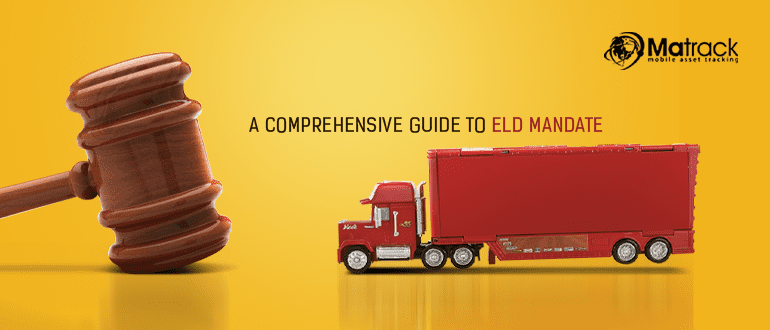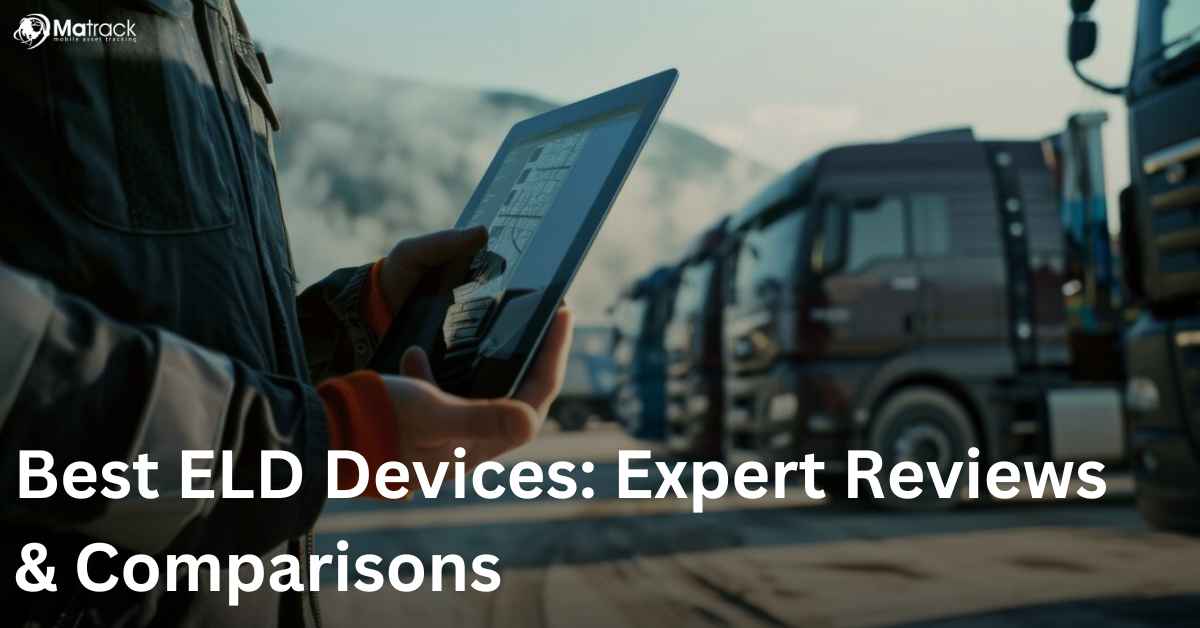Key Takeaways
- The ELD mandate requires commercial drivers to use certified Electronic Logging Device to track driving hours, making roads safer and reducing manual paperwork.
- Not everyone needs an ELD – exemptions include short-haul drivers, vehicles made before 2000, and driveaway-towaway operations.
- ELDs make life easier by reducing errors, speeding up inspections, improving safety, and cutting down on paperwork.
- To get started, assess your fleet, pick a certified ELD, train your team, install the devices, and keep an eye on compliance.
What is ELD mandate?
ELD (Electronic Logging Device) mandate is a U.S. federal regulation requiring commercial motor vehicle drivers to use certified electronic logging devices to track Hours of Service (HOS).
It replaces manual paper logs and outdated systems like AOBRDs (Automatic On-Board Recording Devices).
The mandate’s primary goal is to enhance road safety by preventing driver fatigue, enforcing HOS regulations, and reducing accidents caused by overworked drivers.
History of ELD mandate
The Federal Motor Carrier Safety Administration had been conducting various studies and research to understand and identify the threats to driver safety, and ways to make their work environment safer. Following the research, the FMCSA tried to introduce e-logging, which was met with opposition from federal courts. Various groups like Owner-Operator Independent Driver Association (OOIDA) also objected to e-logging as they thought it would encroach on driver’s privacy and cause grounds for workplace harassment.
FMCSA wanted to adopt an e-logging system as early as 2000. It was believed that an electronic system for logging hours of service would ensure that drivers do not overwork, maintain a healthier lifestyle, and also comply with the DOT rules. The fundamental reason for adopting an electronic system was to decrease the number of accidents involving trucks, as most of these accidents were caused by overworked and fatigued drivers.
Until 2012, FMCSA had a hard time moving ahead with the e-logging system. A breakthrough came when Congress passed MAP-21, a transportation bill that included provision for an ELD mandate to be followed by all commercial motor vehicle drivers and carriers. Because of this step, the ELD gained popularity and support from many truck driver associations and other groups. This encouraged many truck drivers to install electronic logging devices in their vehicles.
In December 2015, the ELD mandate was finalized. But it was introduced in the industry in December of 2017 as OOIDA had launched a legal battle against the mandate. However, the mandate found favor in appeal courts as well as the U.S. Supreme court.
Requirements of the ELD Mandate
Making use of ELDs is compulsory
Drivers are required to follow the Hours of Service HOS and are obliged to bear the FMCSA-certified electronic logging devices. These devices act as an alternative to paper logs as they allow drivers to automate their logging of driving hours.
Data Synchronization
Data synchronization assures that ELDs installed in the vehicle function as intended by recording the start and end of the engine, driving time, vehicle movement, and distance travelled.
Driver Log Accessibility
Driver log accessibility allows drivers to access and change their logged hours on the device. The only restriction the drivers face is that they are not allowed to change or delete any time the device has recorded.
Compliance Documentation
Compliance documentation requires the ELDs in the vehicles to prepare reports to be made available to the police during roadside checks. The driver must also keep the user’s manual of the device and a malfunction corrective device when driving the vehicle.
Malfunction Reporting
Malfunction reporting requires drivers to notify their motor carrier if they encounter an ELD malfunction and the device stops working; until then, the drivers must revert to using paper logs if the operative device is not working for over 8 days.
Who Must Comply with the ELD Mandate?
The ELD mandate applies to most CMV drivers and fleet operators in the U.S. However, certain exemptions exist:
- Drivers operating under short-haul exemptions.
- Drivers of vehicles manufactured before 2000.
- Drivers conducting driveaway-towaway operations where the vehicle being driven is the commodity.
- Drivers operating less than eight days within 30 days.
Know More About: ELD Mandate – Who Is Exempted?
Advantages of the ELD Mandate
Improved Security
Improved security comes from the automated Hours of Service (HOS) management system that aids in boundaries to overcome driver weariness and overwork. With overworking eliminated, ELDs further ensure appropriate driving practices.
Reduced Mistakes
Reduced mistakes are one of the notable strengths of ELDs as they address issues associated with recording logs manually. These devices ensure complete accuracy and non-falsification of records aimed at meeting compliance thresholds.
Reduced Inspection Time
Reduced inspection time is due to the introduction of electronic logs, which eliminate the need for outdated aids during roadside inspections and hence minimize paperwork for drivers and enforcement personnel.
Streamlined Operations
Streamlined operations are advanced in real-time tracking services, enabling fleet managers to view driving behaviours, vehicle locations and compliance all within one interface.
Reduced Administrative Burden
Reduced Administrative Burden has progressed with digitized record keeping, hence reducing the burden of paperwork and easing the access and maintenance of driver logs by fleet managers.
Steps to Implement the ELD Mandate
Assess
Evaluate your fleet and drivers to see if they fall under the ELD mandate. Assess the current logging systems in place and their capabilities for all non-compliant businesses. There may be some upgrades that will be necessary to comply with the standards.
Research
Find an FMCSA-certified ELD and an official ELD-certified list of devices that have been sanctioned. Cost features, ease of implementation into the current systems and use with the current fleet should be included in the considerations.
Educate
Drivers and staff need to be educated comprehensively on how to carry out the functions required while using the ELD, how to change the Hours of Service (HOS) records whenever necessary, and how to handle minor troubleshooting in everyday issues. Compliance requirements, the device’s functionality and the fleet managers’ uses also require sufficient education.
Install
Install ELDs into all vehicles applicable to the mandate, and all must be synchronized with their relevant engines. Testing of the ELD’s data tracking and reporting of information needs to be conducted to ensure functionality.
Establish
Establish communication procedures and internal reporting protocols pertinent to developing and implementing ELD policies. Compile procedures for malfunctioning reporting, inspection readiness and monitoring compliance.
Audit
To ensure compliance with the enforced ELD standards, internal logs need to be reviewed, regular audits conducted, and all complaints directed towards non-compliance areas need to be addressed.
Penalties for Non-Compliance
Non-compliance with the ELD mandate can lead to serious consequences, including:
- Fines ranging from hundreds to thousands of dollars.
- Driver out-of-service orders (OOS).
- Negative impacts on the carrier’s Safety Measurement System (SMS) scores.
Tips for Choosing the Right ELD
Certification
Make sure the ELD is FMCSA-certified so it meets all legal requirements.
Ease of Use
Pick an ELD that’s simple to use to reduce training time and make it easier for drivers to adapt.
Integration Capabilities
Choose a device that works well with your current fleet management systems for smoother operations.
Customer Support
Go with a vendor that offers reliable customer support to quickly fix any issues.
Cost-Effectiveness
Compare prices and features to find an ELD that fits your budget without losing quality.
Conclusion
The ELD mandate is the single most important regulation in the trucking industry that promotes safety, effectiveness and adherence to principles and operational procedures.
Knowing its requirements and advantages and how to implement it facilitates this change for truck drivers and fleet managers.
Adopting the appropriate technology, training, and procedures guarantees compliance and lays the groundwork for more effective and safe operations.



